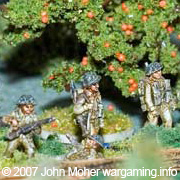 Kieran and I decided to play another “Hit The Dirt” scenario, and at the same time introduce another Auckland Wargaming Club member, Ben, to Crossfire. We selected ‘Reconnaissance Before Pontecorvo‘ (May 1944), as a suitable scenario that matched our available forces on the day and kept the size of the game to manageable with a new player.
Kieran and I decided to play another “Hit The Dirt” scenario, and at the same time introduce another Auckland Wargaming Club member, Ben, to Crossfire. We selected ‘Reconnaissance Before Pontecorvo‘ (May 1944), as a suitable scenario that matched our available forces on the day and kept the size of the game to manageable with a new player.
In the scenario a Canadian Company is attacking, or rather doing a reconnaissance in force, and a German Infantry Company is defending.
The scenario called for a single MMG Section for the British, but as we again had none available for the game, they would instead receive a single M4A1 Sherman to provide direct fire support to the Rifle Platoons.
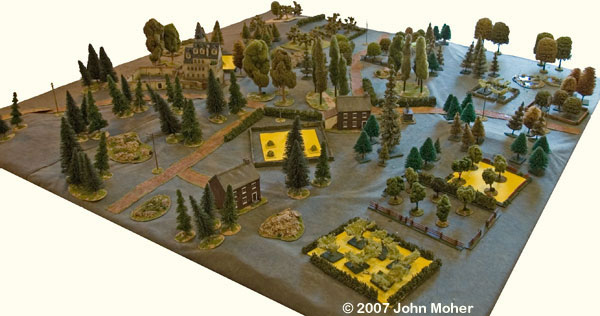
We also gave the Germans full size Platoons (3 ‘Squads’ each) and used our own house rules which include our new Anti-Tank Rules (version 4), our own Sniper rules, and some minor modifications to HE fire and Cover effects. Also as we use 1/72nd scale figures on 40mm bases we enlarged the map 125% (i.e. to 5′ x 5′). Otherwise the scenario and forces were as described in “Hit The Dirt” along with the published victory conditions.
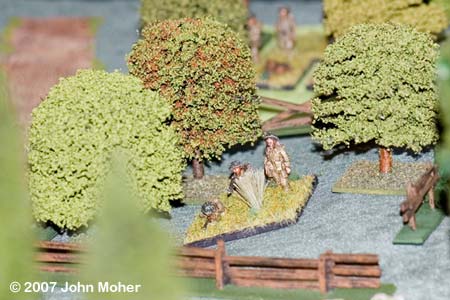
Kieran commanded the German Defenders (yet again), and Ben the Canadians with a little help from Me. The game was played with 1/72nd scale figures (mostly ‘AB Figures’ to be exact) and I got Ben and the Canadians started with a push up the centre, sending No.1 Platoon through the orchards alongside the Pontecorvo Road. Poor old No.1 Section, No.1 Platoon, got the windy works again, being on point at the forefront of the whole advance! The advance went unopposed however and the balance of No.1 Platoon soon joined No.1 Section in the second orchard along the road.
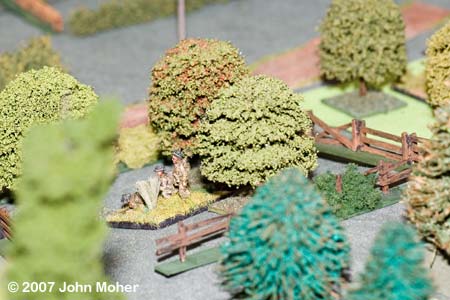
Ben now brought No.3 Platoon on, or rather a section from it, to the left of No.1 Platoon. Advancing into a copse of trees to the South of the ridge line the Section encountered no resistance. Turning North-West the Canadian’s headed for another copse at the West end of the ridge, that would bring them into a position to cover the left flank of No.1 Platoon on the other side of the ridge. However the copse was occupied and they stumbled into a dug-in German rifle section, who’s defensive fire proved erratic allowing the Canadians to infiltrate the wooded position.
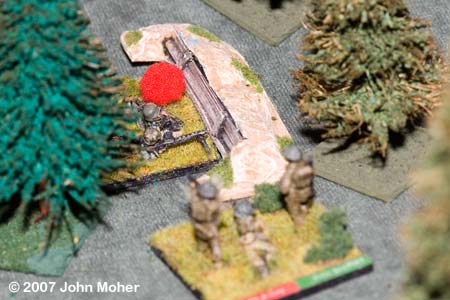
After some discussion between Ben and Myself we decided that since the route of the Canadian Section had shown nearby features to be empty (which effectively covered most approaches to the German position), and their approach had not incited a response from possible enemy positions further away, that rather than gamble on a 1:1 unsupported Close-Assault against the ‘No Fire’ Section we would instead bring up the balance of the Platoon and have the PC lead the other 2 Sections in a direct frontal assault… This, we felt, should allow us to steam roller the isolated German Section before further enemy troops might intervene – so No.3 Platoon’s PC duly lead the balance of the Platoon along the exposed valley floor, adjacent to the ridge…
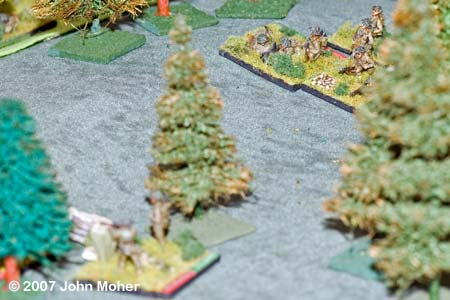
Unfortunately we were ‘sprung’, and a Section of German MMGs opened up at long range… No.3 Platoon got caught in the open and took heavy fire – one Rifle Section was eliminated, and the other and the PC were both pinned.
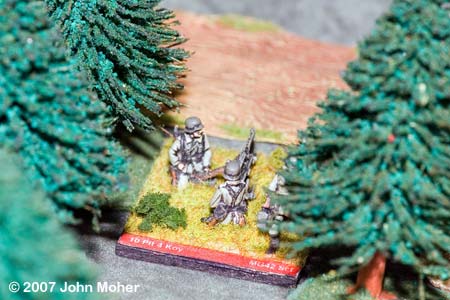
However some sharp work by Ben with the dice soon recovered the situation. The No.3 Platoon PC co-ordinated the CrossFire of his two remaining Rifle Sections on the German MG Section, successfully suppressing it. This was followed up with the first Mortar OP (FO) safely moving up along the ridge to observe the MG position, free from the risk of being gunned down by the MGs! A desultory exchange of fire saw a second CrossFire (against the German Rifle Section) fail and the forward Canadian Rifle Section in the copse then get pinned by the German Section’s fire. By this stage it was 0730 and an hour had passed since the operation began.
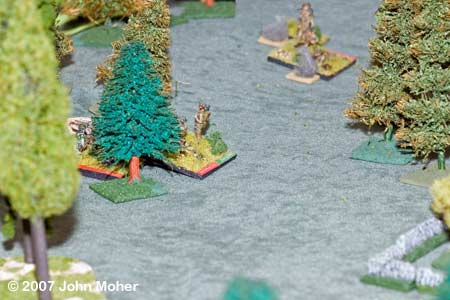
The Canadian Mortar OP called up his section and dropped the mortar bombs right on target – Suppressing the already Suppressed MMG Section – eliminating them from the battle. However the Canadian PC (or rather Ben) promptly followed up with a third CrossFire which suppressed the original German Rifle Section! With continued dice rolling like the last couple of initiatives it was a cinch for the PC to rally himself, and his adjacent Rifle Section, and then complete the move up the valley to assault the now suppressed Germans!
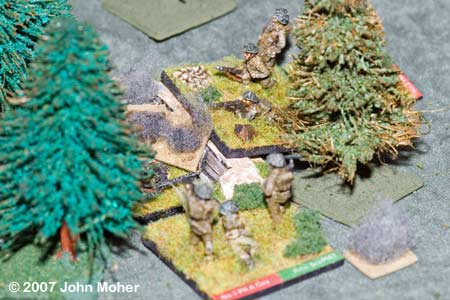
With the German Section easily overrun and it’s position occupied it was time to take stock. No.3 Platoon had taken casualties, and some thought needed to be given to it’s next objective, focus therefore switched back to No.1 Platoon on the other side of the ridge, who began conducting Recon By Fire (RBF) on the closest potential enemy positions – and immediately spotted another German position across the Pontecorvo Road.
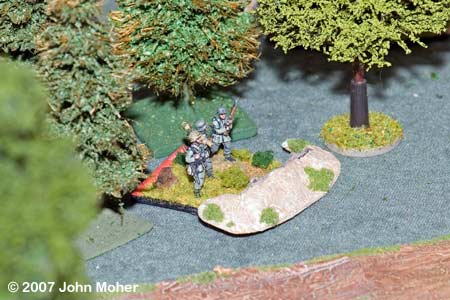
By this stage Ben had also brought up the other Mortar OP, and the CC, and they were in the Orchard behind No.1 Platoon on the North side of the ridge. The picture below gives an overview of how things had progressed in the first hour of the morning…
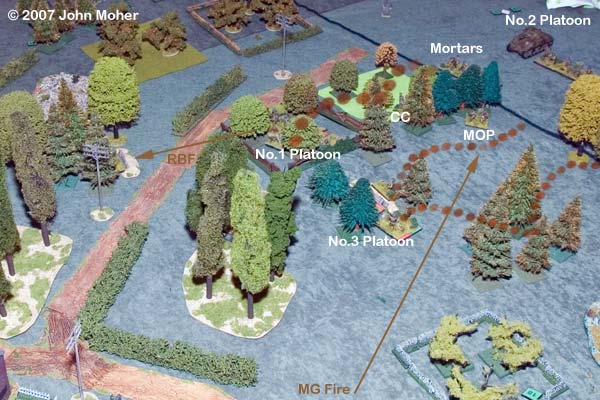
Further RBF, this time by No.3 Platoon, confirmed one orchard to the South as empty and to the West located an entrenched German Rifle Section and their PC in another copse (lower centre in the photo above). No.3 Platoon then concentrated their fire on the Western German position, while No.1 Platoon fired at the North-Western position across the Pontecorvo Road. No.3 Platoon were also further assisted by the first Mortar OP team moving up to support them in their copse, and bringing effective fire to bear on the nearby Germans despite their entrenchments. Together they inflicted multiple suppressions and eliminated another German position. So far the Canadians had successfully identified 3 German positions, and also eliminated 3 German Sections (2 Rifle & 1 MMG) towards their Victory Conditions, with the loss of only 1 Rifle Section.
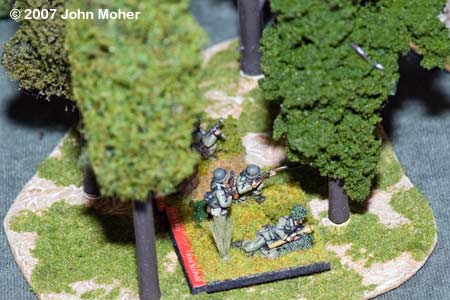

With the success of their fire, the Mortar OP team was now free to leave No.3 Platoon and move back over the ridge to support No.1 Platoon. Meanwhile No.3 Platoon moved forward to occupy the Westerly German position, the move however being interrupted by fire from a new enemy position. The fire came from a Sniper who managed to suppress the PC and leave him stranded in the open. However the 2 Rifle Sections occupied the copse, taking prisoner the German Platoon PC in the process. Meanwhile No.1 Platoon has also been successful and repeated CrossFire’s with all 3 Sections had scored multiple suppressions on the entrenched German Rifle Section eliminating it and opening up the first part of the Pontecorvo Road.
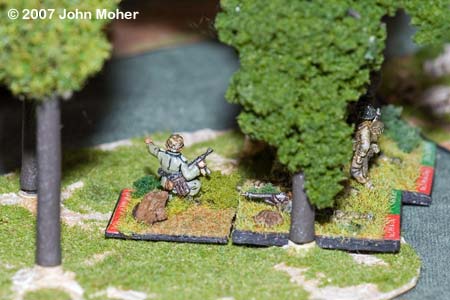
As the German MMG Section that was eliminated earlier was to the South-West, and this was also where the new Sniper fire was coming from, it was felt there would be less likelihood of significant other troops in the immediate vicinity and hence that that area would be easier to infiltrate. No.3 Platoon was earmarked to advance in this area but first the Sniper needed eliminating – so the Mortar OP was brought back over the ridge to support No.3 Platoon, although he was then immediately targeted by the Sniper and pinned. One Rifle Section of No.3 Platoon tried to assist but their fire against the Sniper was ineffective.
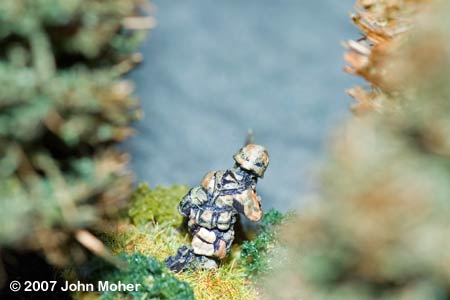
Behind No.1 Platoon meanwhile, the Company Commander, and the second Mortar OP moved forward from their position in the first orchard, into the orchard with No.1 Platoon to support them more directly, and in anticipation of a possible advance by No.1 Platoon. South of them the first Mortar OP was unsuccessful with fire on the German Sniper, as was the closest Rifle Section from No.3 Platoon. The German initiative resulted in Sniper fire suppressing the Mortar OP (who were, incidentally, in the copse by the ridge that No.3 Platoon had previously vacated).
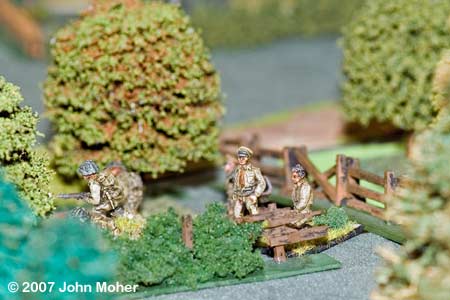
Feeling we were potentially stalemated until we dealt with the Sniper, I suggested to Ben we bring the Sherman on so it was handy to support the Rifle Platoons – it therefore made a cautious advance up the Pontecorvo Road until it was adjacent to No.1 Platoon’s position. To the South the Mortar OP failed to rally, losing the initiative, but luckily the on-going harassing fire from the Sniper was ineffective and had no effect.
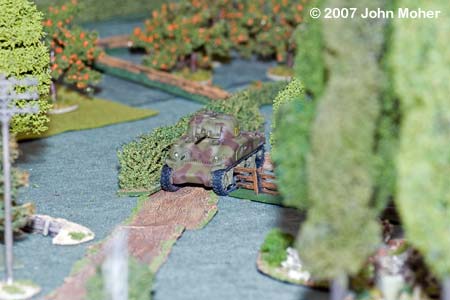
Up until now No.2 Platoon had been held behind the start line as our reserve to deal with any unforeseen circumstances, but Ben now felt the time was right to commit it. With a partial stalemate in the Centre-South he believed an advance North of and parallel to the Pontecorvo Road might open things up a bit – so No.2 Platoon moved forward into an orchard just past the start line. They were immediately harassed by Sniper fire coming from the North-West, although this was initially ineffective.
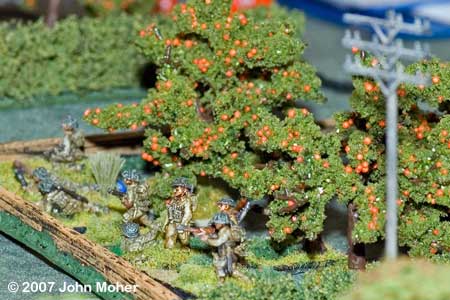
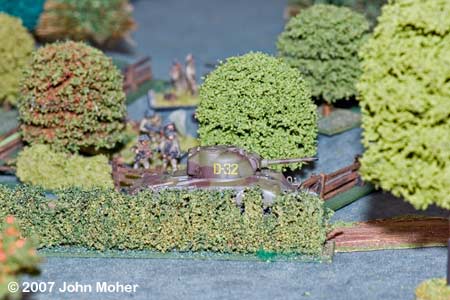
Events to the South continued to be ineffective for the Canadians – the Mortar OP remained suppressed by the Sniper, the Rifle Section from No.3 Platoon was unable to suppress the Sniper alone, and the second Mortar Op was not considered to assist as although his mortars were committed to smoke missions, their ammunition was (at least temporarily) in limited supply. As such time ticked by for a while with just sporadic sniping and a lack of activity by both sides, until about 0830.
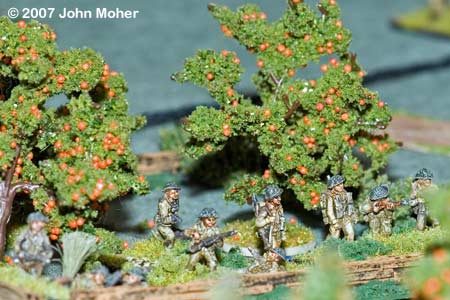
In the meantime No.2 Platoon came under increasing harassing fire from the Northern Sniper, who although largely ineffective did manage to re-pin or suppress the closest Rifle Section immediately whenever it did successfully rally a previous pin or suppression result. No.2 Platoon became inactive in the face of this harassing fire and effectively took no further action during the morning operation – one would suspect questions will be asked of the PC in the post operation investigations!
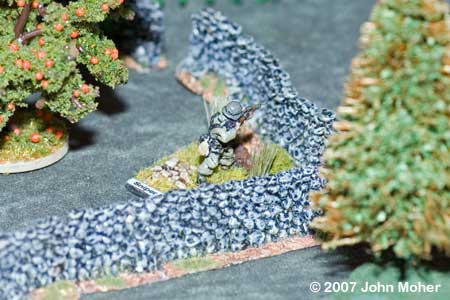
Around 0830 Ben got lucky and the Rifle Section from No.3 Platoon suppressed the Southern Sniper, and the Mortar FO also rallied (but his fire was unsuccessful against the Sniper). The decision was made to use the opportunity to launch part of No.3 Platoon on their Westward mission, and overrun the sniper in the process! The PC and one Rifle Section immediately set out, on what was a reasonably exposed advance for some distance, however they did not get far as they immediately stumbled into a concealed minefield! The effect was catastrophic, with the Rifle Section being eliminated and the PC left suppressed and stranded in the middle of the mines… At the same time on the Pontecorvo Road the Sherman was suddenly targeted by a mortar bombardment from an unknown observer – the Sherman receiving a suppression.
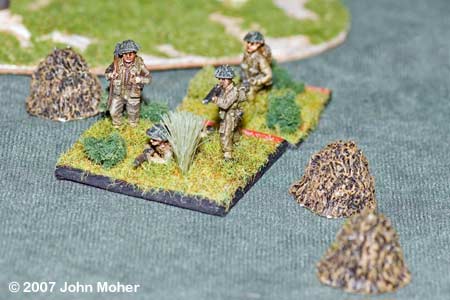
Meanwhile the German Sniper rallied and resumed fire on the Mortar OP but was only able to pin it – the Mortars did then suppress the Sniper, and the last Rifle Section of No.3 Platoon headed off to try and deal with it, skirting around the East side of the minefield, and into the previously observed empty orchard. However upon entering they were immediately targeted by a new Sniper to the South-East – who successfully suppressed them. The original Sniper then rallied and the two of them attempted to ‘finish off’ the suppressed Rifle Section and Mortar OP (albeit unsuccessfully), while 8cm mortars continued to bombard the Sherman, but with no further success.
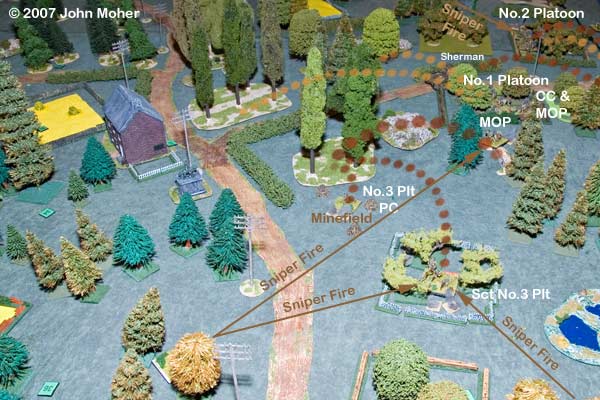
At this point (about 0930) the Canadians were mostly in a reasonably strong position in terms of the scenario victory conditions – they had only lost 2 stands (so might still safely exit 9 to the East), had observed or occupied 3 German Positions (3 Entrenchments), had eliminated 5 enemy stands, and might still retire with 2 hours to spare – this equated to 19.5 VPs, more than enough for a Canadian Victory (and just 0.5 points short of a Decisive one). Unfortunately a couple of Canadian stands were suppressed in exposed positions, and the likelihood of safely retiring everyone by 1000 (with 2 hours to spare) was slim – still Ben and I felt a Decisive Victory was still reasonably achievable if we could observe or occupy one more position quickly and possibly eliminate at least 1 more German stand while only losing 1 more of our own stands – but we had to do it quickly, ideally by 1000 if possible (which could arrive at the next German initiative). The next move was to locate the OP bringing the mortar fire down on the Sherman, which No.1 Platoon was tasked with – In hindsight we should have instead begun preparations for a withdrawal. Meanwhile the German mortars scored a second suppression on the Sherman, and the Snipers continued to target the exposed Canadian troops.
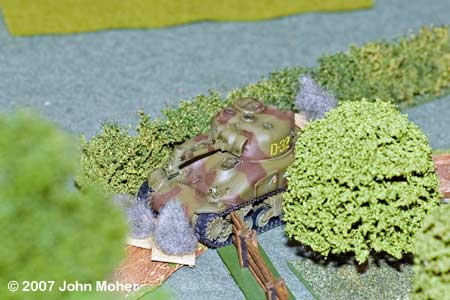
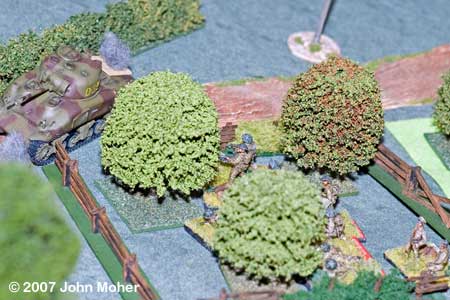
So, with the next Canadian initiative, No.1 Platoon began by sending one Section across the road to occupy the German position they had eliminated earlier in the morning, then the balance of the Platoon (two Sections and the PC) made an advance to the North-West into a copse by the road intersection. Meanwhile back to the North, No.2 Platoon’s Sections conducted retreat moves out of the orchard once the suppressed Section had rallied – they had proved powerless to deal with the lone Sniper harassing them and had become rather inert in their orchard. Once out of the orchard they marched South across the road, adjacent to the Canadian Start-Line, to the position where No.1 Platoon had originally advanced from. Back at the road intersection No.1 Platoon began conducting RBF and they were immediately successful locating the enemy Mortar OP, as expected, in the large Farmhouse opposite the intersection. However a CrossFire from the two Rifle Sections with the PC was unsuccessful and initiative passed back to the Germans. The Company Commander did successfully rallied the Sherman during the initiative though, meaning it was ready to back-up No.1 Platoon. The first Canadian Mortar OP was also able to rally and get back out of the copse and out of LOS of the two snipers that had been shooting it. He subsequently moved over into the orchard previously occupied by No.1 Platoon, observing events down the road.
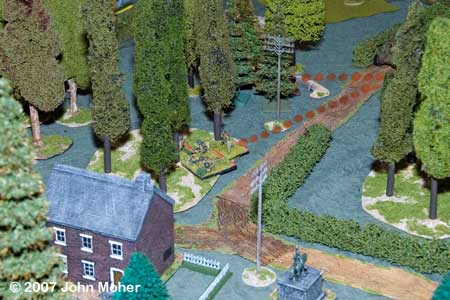
Smack! The German 8cm Mortar OP immediately got his Section’s mortars on target against No.1 Platoon – a Rifle Section was decimated and the survivor and PC suppressed. Elsewhere the German Snipers continued their deadly game, both targeting the No.3 Platoon Rifle Section, while the Sniper to the North changed positions, moving South into an orchard where he could view both the tail end of No.2 Platoon (marching South) and the Section of No.1 Platoon in the old German entrenchments. His harassing fire immediately suppressed the last No.2 Platoon Section and exposed the Canadian’s line of withdrawal. In the following initiative this Sniper eliminated the end Section from No.2 Platoon with a subsequent suppression and then (about 1000) shifted his attention to the No.1 Platoon Section, effectively keeping them suppressed for the next hour and a half! The Canadians responded to this by retiring No.2 Platoon (somewhat ignominiously) off the table, and also retiring their Company Commander as well! In the South-West the original Sniper also put the No.3 PC out of his misery, as he was still suppressed in the open in the middle of the minefield and easily finished off.
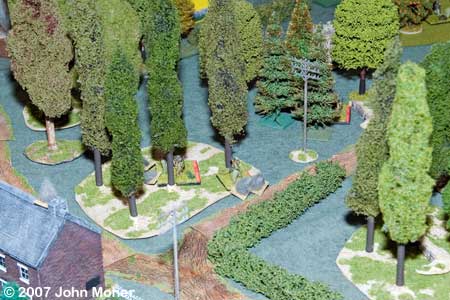
Repeated attempts were made to eliminate the German Mortar OP – the Sherman blasted away with it’s hull MG and 75mm gun, the first Canadian Mortar OP bombarded the house, but to no avail, the best result being a pin. The German mortars continued to pound the suppressed members of No.1 Platoon and soon another Rifle Section was gone, leaving the PC isolated and suppressed. It was decided it was time for a hasty Canadian withdrawal, as time was flying by (1000 was well passed), and in preparation a smoke screen was laid to the North by the second Mortar OP to screen off the Northern Sniper so the remnants of No.1 Platoon could try to withdraw. Unfortunately the rally attempt failed and the German mortars now shifted their attention up the road to the last Rifle Section, attempting to finish off what the Sniper to the North had started! To try and resolve matters to the South the Sherman reduced it’s attempts at the house (leaving it’s Hull MG to harass the German Mortar OP in that building) and brought it’s main gun’s attention to the Snipers to the South. This was unfortunately very unsuccessful.

Meanwhile the first German Sniper temporarily repositioned to the North-West and took out the suppressed No.1 Platoon PC with a well aimed shot! He then moved back to the South. The two Southern Snipers then eliminated the suppressed remnants of No.3 Platoon in the South over the course of two initiatives and the South-East Sniper moved up into the orchard that the Canadians had just recently been occupying. By this time it was 1100 and the Canadians had one last chance to try to save the remaining Section of No.1 Platoon… Needless to say it went poorly. Fire from the Sherman was ineffective, even though it had left the road and headed South, bringing it’s Hull MG & main armament to bear on the third Sniper, in the orchard. However the German Mortars did fall silent, offering a reprieve, at least for a moment (in fact they had actually exhausted their ammunition).
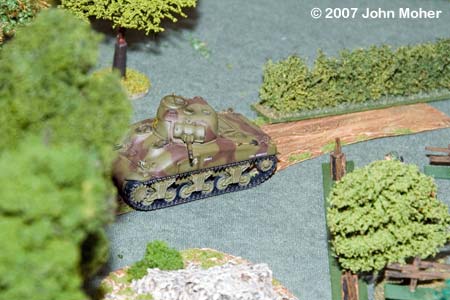
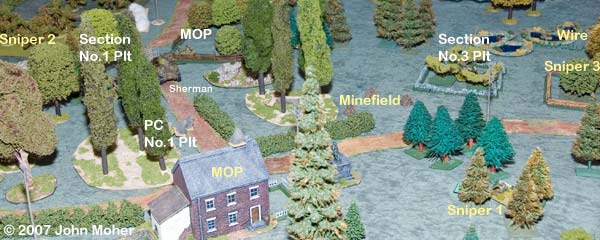
Then it was all over, a shot from the Northern Sniper finished off the last Rifle Section (from No.1 Platoon) and there was nothing left for the Sherman but to retire, it being 1130 by the time it returned across the start line. The two Canadian Mortar OPs covered the retirement, but the German forces showed no desire to make one last effort to chase them – and by 1200 it was all over, the Canadians had taken heavy casualties in the end, and only secured a limited amount of reconnaissance. It was a grim day for A Company, 48th Canadian Highlanders!
The Final Tally:
| Victory Conditions | Number | VPs |
|---|---|---|
| Sections Exited (Rifle/CC/Tank Stands) | 4/11 | 4.0 |
| German positions Observed | 4/7 | 8.0 |
| German Stands Destroyed | 5/16* | 2.5 |
| Completed each Hour before Noon | 0/5 | 0.0 |
| Total: | 14.5 |
* Should normally be only 13 possible in total. Totals exclude Snipers.
11-15 Victory Points = German Victory.
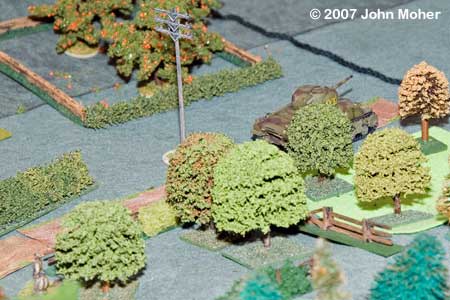
Lessons from the Game
- My Sniper house-rules used in this game can make snipers potentially too powerful in the scale of the game – in this case they probably unbalanced the scenario. My expanded ideas took them into the realm of actual 1:1 ratio skirmish gaming and too far from the level of abstraction inherent in Crossfire. The way snipers are represented in Crossfire currently is far more suitable – as such we only used these ideas one more time before discarding them as unnecessary and also not in keeping with the game’s scale.
- Adding the additional German Squads in making the Rifle Kompanie full strength was unnecessary, especially with the HMGs present – although these extra squads took no part in our game, for Kieran (the German Defender) they no doubt allowed him easier choices about covering the probable approaches (i.e. more troops available so less tough decisions about deployment).